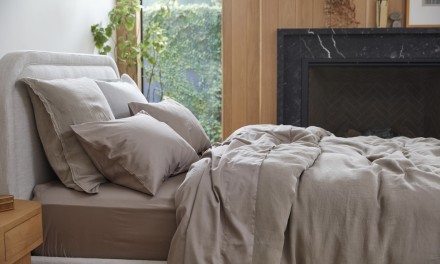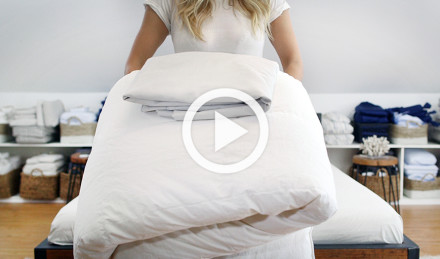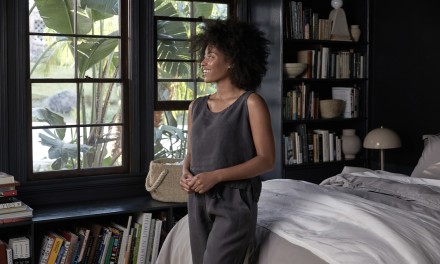Maybe you sleep hot year-round, like to keep cool under a down comforter or want the option to layer on bed covers to achieve your optimal sleeping temperature. On the other hand, maybe you recently moved to a warmer climate and are adjusting to the humidity, or perhaps you're simply in the market for a set of summer bed sheets. In any case, lightweight bedding is the way to go.
But what is lightweight bedding, exactly, and what are the best materials for those looking for cooling fabrics? Find answers to these questions below, along with expert insight into the benefits of light, breathable bed covers and what to consider when shopping for products.
What Is Lightweight Bedding?
What Is Lightweight Bedding?
Lightweight bedding is essentially breathable or otherwise cooling bedding. By encouraging airflow, wicking away moisture and not trapping heat, it helps regulate your body temperature. It's ideal for those who get night sweats or run hot while sleeping, though anyone can benefit from light bedding materials.
Benefits of Lightweight Bedding
Whether it's cooling sheets, breathable bed covers or a moisture-wicking duvet, there are many reasons to reach for lightweight materials. For one, overheating or perspiring at night can make it hard to get high-quality shut-eye, and lighter fabrics will help you stay cool as you doze.
When you sleep under breathable fabrics, hot air won't get trapped beneath the covers. As a result, you're less likely to wake up sweating throughout the night. And if you do perspire a little, the sweat-wicking textiles will draw moisture away from your body.
If you think this means you'll be cold at night, think again. Lightweight and breathable don't equate to chilly. The beauty of these all-star fabrics is that they offer adequate ventilation and the perfect level of insulation to simultaneously keep you comfortably cool and snuggly warm.
What Type of Sleeper Should Use Lightweight Bedding?
Lightweight bedding is the best of all worlds. It's breathable yet insulating, cozy yet cooling and perfect for year-round use. While it might seem like cooling fabrics are better for those prone to night sweats, they're actually ideal for virtually every type of sleeper — even those who tend to get cold at night. That’s because rather than simply cooling, these fabrics work to regulate temperature.
With that said, some types of breathable bedding are a little warmer than others. Check out our guide on How to Pick Bed Sheets Based on How You Sleep to figure out what material is best for you.
The Best Lightweight Bedding Materials
When it comes to breathable bedding, the best materials are naturally sourced. These materials include linen, percale, sateen, brushed cotton and down, each of which is remarkably breathable, with inherent moisture-wicking properties. Whether you're considering the best bed sheets for night sweats or just prefer a lighter material, here's the fabrics you should know.
Linen Bed Sheets
The Best Lightweight Bedding Materials
When it comes to breathable bedding, the best materials are naturally sourced. These materials include linen, percale, sateen, brushed cotton and down, each of which is remarkably breathable, with inherent moisture-wicking properties. Whether you're considering the best bed sheets for night sweats or just prefer a lighter material, here's the fabrics you should know.
Linen Bed Sheets
Linen bedding is one of the most sought-after textiles, and for good reason. Loomed from the natural fibers of flax plants using a square weave structure, the fabric is notably strong yet incredibly airy.
This brilliantly breathable bedding material encourages airflow to pass through, allowing your skin to breathe while wicking away any excess moisture. Those who sweat at night or live in humid regions will appreciate easy-breezy linen, though it's a top choice for every season and climate.
If you're not already convinced, get this: linen actually gets softer every time you wash it. Plus, the naturally hypoallergenic textile is gentle on sensitive skin and unlikely to cause a reaction.
To learn more about this lightweight summer bedding material, see our article, Linen: Know Your Bedding Like a Designer.
Types of Breathable Cotton
Cotton reigns as the most popular lightweight bedding material. It's affordable, versatile and soft — not to mention naturally breathable and absorbent. Hypoallergenic cotton doesn't trap heat and does an impressive job of wicking away sweat as you catch those Zs. Which is to say, you can count on quality shut-eye with fewer wake-ups and no damp, sticky skin in the morning.
With all this in mind, there are a few different types of cotton to consider when buying bedding. This includes percale, sateen and brushed cotton. Get details below.
Percale Cotton Bed Sheets
Percale is a type of Egyptian cotton, meaning it's woven from long-staple fibers sourced from cotton plants grown along the Nile River in Egypt. Loomed with a plain square weave, this natural textile boasts a smooth and crisp matte finish for undeniable hotel-bed vibes.
Cool-to-the-touch percale bedding is also naturally breathable and surprisingly lightweight. It's perfect for those who get hot or sweaty at night, as the high-quality cotton encourages moisture to evaporate. And like linen, percale gets softer with every wash.
For a deeper dive into this cooling bedding material, check out our guide, Percale: Know Your Bedding Like a Designer.
Sateen Cotton Bed Sheets
If you appreciate the silky-smooth finish of satin but want something a bit more breathable, sateen is your best bet. Like percale, it's a type of Egyptian cotton. But thanks to its four-over-one-under weave, the exceedingly sumptuous fabric is drapey with a subtle sheen.
Softer than satin and a little warmer than linen and percale, sateen bedding is ideal for those who like sleek or cozy fabrics and prioritize breathability. What's more, it doesn't require special care, and like the lightweight textiles mentioned above, the texture of sateen improves over time.
Discover more about this lightweight material in our guide, Sateen: Know Your Bedding Like a Designer.
Brushed Cotton Bed Sheets
Then there's brushed cotton, which is somewhat warmer than percale and slightly cooler than sateen. After raw cotton fibers are spun into threads and woven into a textile, the surface is gently rubbed (or brushed) using a fine-toothed metal comb. The resulting slightly raised fibers offer mild insulation and a buttery-soft feel.
Brushed cotton bedding is similar to flannel but not quite as warm because it's only combed on one side. The ultra-cozy yet breathable and moisture-wicking material is the perfect balance of snuggly and lightweight. Some people opt for brushed cotton in the fall and winter, but the airy material doesn't trap heat, so it's suitable for year-round use.
Discover more about this velvety bedding fabric in our article, Brushed Cotton: Know Your Bedding Like a Designer.
Down
Down is the soft, fluffy underlayer found on the feathery coats of geese and ducks. It's often used to fill duvet inserts, pillows, mattress toppers and mattress pads. Down bed pillows and comforters from Parachute are certified by the Responsible Down Standard, meaning the supply comes from humanely treated fowl.
The cloud-like bedding material is inherently lightweight but also naturally insulating and even absorbent. Generally speaking, down is suitable for year-round use, though fill power can affect the warmth, insulation and overall fluffiness of individual products.
Find out how this lofty material compares to microfiber fill in our Down vs. Down Alternative Comparison Guide.
Lightweight Bedding Products
What breathable bedding products should you get? Every sleeper is different, but you'll want to consider sheets, a comforter, a duvet cover, pillowcases and potentially a new mattress.
Sheets
Lightweight Bedding Products
What breathable bedding products should you get? Every sleeper is different, but you'll want to consider sheets, a comforter, a duvet cover, pillowcases and potentially a new mattress.
Sheets
If you're new to breathable bedding, lightweight sheets are a great place to start. You can get a complete set with a top sheet, bottom sheet and one or two pillowcases. Alternatively, you can forgo the top sheet and opt for just a fitted sheet. At any rate, percale, linen, sateen and brushed cotton are excellent choices.
Lost on what sheets to get? These guides offer useful insight:
Guide to Bed Sheets: Choose the Right Fabric and Style for Your Bed
What Is a Top Sheet and Do You Actually Need One?
Comforter
The next thing to consider is a comforter (aka duvet). If you want something cooler, go with a lower density fill power, and if you're in the market for a year-round bed cover, opt for something with a higher fill power.
As mentioned above, down is the best fill material for a lightweight duvet insert, but the shell of the comforter matters too. Look for cool bedspreads with 100% cotton shells, whether it's crisp percale or silky sateen. This will ensure sweat is wicked away as you snooze, while regulating your body temperature throughout the night.
Duvet Cover
You'll also want to get a duvet cover, which is essentially a machine-washable enclosure for your comforter. As with the shell of your duvet insert, breathability is key. You don't have to get a duvet cover in the same fabric as your sheets, though your best options are brushed cotton, linen, percale and sateen.
Learn more about these must-have bedding products in our Guide to Duvets and Duvet Covers: Everything You Need to Know.
Pillows
A bed pillow doesn't hold as much weight as bed linens in terms of regulating your body temperature — but it's still a crucial component of keeping you cool at night. If you're partial to light and fluffy materials, down is a great choice, and like comforters, you'll want to look for a breathable cotton shell.
Having said that, down pillows are typically best for stomach-sleepers, as the compressible material helps keep the neck in a neutral position. Those who slumber on their back or side may want something a bit firmer.
Which bed pillow is right for you? Read our Pillow Guide: How to Choose the Right Pillow to find out.
Pillowcases & Shams
Just like your duvet insert needs a cover, your bed pillow needs a case. Pillowcases and shams are often included in sheet sets and duvet sets. That said, you can always purchase them à la carte if you have something specific in mind or like to change out your pillowcase every couple of days.
Learn more about how to choose the best options for your bedroom in our Pillowcase and Sham Guide.
Consider a Breathable Mattress
The materials underneath you are just as important as your bed covers. With this in mind, you might also consider getting a breathable mattress. Look for a foam-free option featuring layers of pure wool and organic cotton, along with zoned coils for full-body support.
Find out why Parachute's mattress checks all the boxes in our guide, The Eco Mattress: Everything You Need to Know.
Can You Use Lightweight Bedding Year-Round?
As a matter of fact, you can! Materials like linen, cotton and down are naturally breathable but still plenty cozy for year-round use. Having said that, some people like to have a designated summer comforter or a set of breezy linen sheets for the warmer months, and reserve more snuggly fabrics like brushed cotton and high-density down for the winter.
Cozy Bedding Products
There's no reason not to use cooling bed linens year-round. You can always add an additional lightweight blanket in the chillier months and continue adding layers until you reach the perfect sleeping temp. However, if you want something a little cozier to layer over your lightweight bedspread, consider flannel, wool or matelasse.
Take a look at these guides for more insight into layering bed covers and creating a cozy sleeping environment:
Matelasse: Know Your Bedding Like a Designer
Guide to Quilts, Blankets and Coverlets: A Modern Take on Traditional Covers
How to Care for Lightweight Bedding
How to Care for Lightweight Bedding
You'll always want to check the care label before washing, but generally speaking, the breathable bedding materials mentioned above are easy to clean. Your best bet is to run your fabrics on a gentle cycle using cold or warm water. (Hot water isn't recommended, as it can shrink or degrade the textiles over time.)
Additionally, you may want to pour the laundry detergent in first — a quarter-cup should be plenty. This will help it dissolve in warm or cold water and distribute evenly. Natural laundry detergent is ideal, as it's biodegradable, easy on your bed linens, tough on stains and gentle on sensitive skin.
Plant-sourced bedding materials like cotton and linen are more prone to wrinkling than synthetic textiles. Consider tossing in a few wool dryer balls to cut down on your drying time, fluff up your fabrics and reduce wrinkles. Another way to minimize wrinkles is to take your bedding out of the dryer and make your bed when the materials are roughly 85% dry.
See these guides for detailed instructions and expert insight into laundering bedding:
How to Wash and Properly Care for Bedding
How Often Should I Wash Cotton Sheets?
How to Wash, Dry and Properly Care for Sateen Sheets
How to Wash, Dry and Properly Care for Percale Cotton Sheets
How to Wash, Dry and Care for Your Linen Sheets
Do Dryer Balls Really Work? Everything You Need to Know About Wool Dryer Balls
Laundry Room Accessories 101: Laundry Essentials You Need for Clean Living
Naturally Cooling and Lightweight Bedding Materials from Parachute
If you're in the market for new bedding, you've come to the right place. Parachute is proud to carry luxury bed linens at affordable price points, including everything from lightweight bedding sets to individual sheets to down-filled inserts.
When you shop our collections, you'll find cooling sheets and pillowcases, lightweight quilts and coverlets, down-filled comforters, bed pillows and everything in between. Start browsing today!
If you need help mixing and matching different fabrics or want expert guidance on layering a bed, a seasoned Parachute stylist is here to assist. Schedule your complimentary one-on-one consultation to get started.
Read Next:
Best Bed Sheet Materials for Night Sweats
Down Fill Power: Down Comforter 101
How Often to Replace Sheets, Pillows and Other Bed Linens
Parachute Guide to Mattress and Bedding Protectors
Sateen vs. Satin vs. Silk: What's the Difference?
31 Bedroom Color Trends and Inspiration
Are Organic Sheets Worth It? Why "Organic" Can Be Misleading
How to Design and Style a White Bedroom
How to Design a Black Bedroom Beyond Monochrome
Naturally Cooling and Lightweight Bedding Materials from Parachute
If you're in the market for new bedding, you've come to the right place. Parachute is proud to carry luxury bed linens at affordable price points, including everything from lightweight bedding sets to individual sheets to down-filled inserts.
When you shop our collections, you'll find cooling sheets and pillowcases, lightweight quilts and coverlets, down-filled comforters, bed pillows and everything in between. Start browsing today!
If you need help mixing and matching different fabrics or want expert guidance on layering a bed, a seasoned Parachute stylist is here to assist. Schedule your complimentary one-on-one consultation to get started.
Read Next:
Best Bed Sheet Materials for Night Sweats
Down Fill Power: Down Comforter 101
How Often to Replace Sheets, Pillows and Other Bed Linens
Parachute Guide to Mattress and Bedding Protectors
Sateen vs. Satin vs. Silk: What's the Difference?
31 Bedroom Color Trends and Inspiration
Are Organic Sheets Worth It? Why "Organic" Can Be Misleading
How to Design and Style a White Bedroom
How to Design a Black Bedroom Beyond Monochrome

















